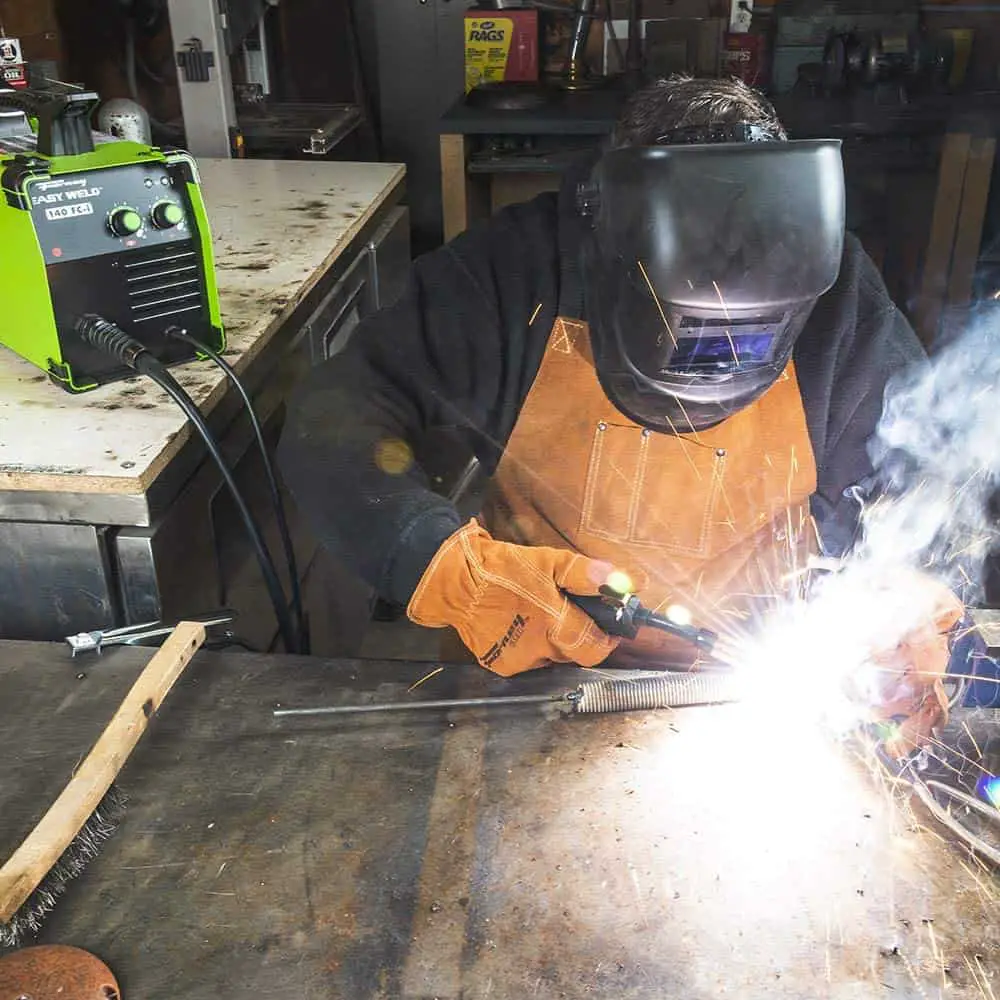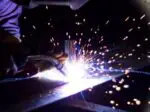 MIG welder is known to use a shielding gas such as argon or helium for completing the weld!
MIG welder is known to use a shielding gas such as argon or helium for completing the weld!
So, are you wondering how can a MIG welder work without a gas cylinder?
To your surprise a non-gas MIG welder too make use of the gas but not in the form of a gas cylinder but in the form of a flux core wire which is hollow at the core and which ultimately releases the gas when burnt!
Wondering how to use the non-gas MIG welder for welding your metal?
Well, this article then is the perfectly place for you as your search ends here!
In this article I have elaborated all the steps in details on how to use a non-gas MIG welder!
So, without wasting any further word, let’s just jump into the topic…
Steps on how to use a non-gas MIG welder:
Before starting on with the steps of welding, you need to ensure that you have taken all the safety precautionary measures because welding involves dealing with heat, sparks, flames, flying molten metals, electricity, etc.
You need to wear the PPE that is required in welding which includes safety gloves, welding helmets, masks, safety glasses, EH rated boots, and safety shirts or vests.
Wearing all the safety gears will not only ensure safety, but will also let you work comfortably because you are then no more exposed to the heat and fumes that are produced in the process.
When you are well equipped with safety gears, you can then proceed for the welding activity which includes the following steps in case of a non-gas MIG welder:
Step1: Cleaning of the metals:
In order to ensure that you get a perfect weld, you need to take care that there are no impurities or foreign particles that is dust, dirt or debris in the metal. If the dirt is not cleaned thoroughly, they might react chemically or physically with the electrode later and lead to porous or cracked weld. Therefore, cleaning the surface of the metal is very essential prior to welding.
For cleaning the metal you can either use a wire brush or can use soapy water solution and remove the dirt using a paper towel or toothbrush. The other way to clean the dirt is by grinding which is used only in case of settled stubborn dirt.
Just remember, if you are using the grinding technique, you need to be gentle on the metal or it might take off the essential layer of the metal to be welder or in worst cases might break the metal as well.
Step 2: Adjusting the settings in the flux core MIG welder:
For MIG welding without gas, you need to choose a machine that is above 115 volts. After that select the settings in the control panel of the machine that has the number of amps mentioned.
Now, the number of amps required for carrying out the welding will depend on the type of metal to be welded as well the thickness of the metal. Normally, for a metal like steel with a thickness of ¼”, the machine should be set at 180 amps.
Step 3: Switching the machine on:
Before you switch on the machine, you need to ensure that all the connections are up to the mark, which means that no wire is coming out or is not connected to the machine and is left open or the switch board is perfect. Once you have checked all the connections, you can now switch on the machine.
Step 4: Choosing the correct current strength:
Choosing the current again depends on the type of the metal and the thickness of the metal as well. The thicker and stronger the metal is, the more will be the required amount of current. For example, softer metals like aluminium will require less current (heat) to be welded than stronger metals like steel.
Step 5: Setting of the wire feed:
This works just like your car. As your car works on different gears depending on the speed so does a welding machine!
You need to set a particular gear for a particular speed of the wire feed and then you need to adjust the speed of the wire feed depending on the type of metal you are using.
Step 6: the welding:
Clamp the metal in the desired area and bring the flux core near the metal and switch the machine on. You can adjust the heat by lowering the current settings if required in the process the flux core will release the cloud of gas to be filled in the weld pool in order to protect the weld. Once the welding is done, switch the machine off and you are done!
Before un-mounting the welded metal from the clamp, let it cool for a few minutes and get hardened.
See also: Can you use a mig welder without gas
Benefits of non-gas MIG welder:
The non-gas MIG welder has the following benefits:
-
-
- It enables to for decent bonds in the presence of oxygen
- It can be carried out outdoors because the flux core produces slag the does not allow the weld to react with atmospheric gases
- The flux core wires are easily carried everywhere which is not the case with gas cylinders
- No need to clean the metal prior to welding because the penetration power of flux core is very high
-
When to use a non-gas MIG welder?
You can use a non-gas MIG welder in the following cases:
-
-
- When welding outdoors because flux core arc welding does not get affected by wind
- When welding strong and thick metals because the penetration power of flux core is very high
-
Difference between a non-gas MIG welder and a gas MIG welder
| Parameters | Non-gas MIG welder | Gas MIG welder |
| Portability | The flux core wires are easily portable | The heavy gas cylinder are difficult to transport |
| Outdoor welding | You can weld outdoors using a flux core arc welder because they will burn even in wind and you do not need any external source of shielding | Not possible in windy and rainy weather |
| Penetration power | Much more | Lesser |
| Prior cleaning of metals | Not required because flux core allow you to work on dirty galvanised metals | The metal needs to be cleaned prior to welding |
| Fume generation | More | Less |
| Ease of use | Complicated as you can’t control the direction of the gas and flux core being fragile is difficult to handle | Easy to use as you can direct the position of the gas as you require and change position comfortably |
| Position of application | Not directed | Directed |
The chart above shows you all the differences between a non-gas MIG welder and a gas MIG welder, but the basic difference lie in the use of the shielding gas.
Whereas a normal MIG welder will use a shielding gas cylinder, the non-gas MIG welder uses a flux core wire instead that is hollow at the core and which ultimately produces the gas to be filled in the weld pool.
Best non gas MIG welder: Our top 3 picks
1.) Forney Easy Weld 261
- EASY TO USE-140 FC-I MIG machine uses 0.30, flux core wire.
- POWERFUL- Up to 140 Amp output
- PORTABLE WELDER- Lightweight 19 lbs
- RUGGED- All metal case
- WELDER INCLUDES- 8 MIG gun, 8 ground clamp, Integrated handle with torch wrap and a 20A-15A adapter. Backed by a 12-month warranty
Prices pulled from the Amazon Product Advertising API on:
Product prices and availability are accurate as of the date/time indicated and are subject to change. Any price and availability information displayed on [relevant Amazon Site(s), as applicable] at the time of purchase will apply to the purchase of this product.
2.) Hobart 500572 Handler 100
- Allows you to weld up to 3/16 in. (4.8 mm) steel with flux-cored wire.
- Provides a broad operating window for each wire, with quick and easy adjustment for different thicknesses and joints.
- Offers you flexibility to use small or large spools of wire to better suit your welding needs.
- Eases use and excellent safety feature which makes wire electrically “cold” until trigger is pulled.
- Positive feed with adjustable tension Plus easy accessibility to thread new wire.
Prices pulled from the Amazon Product Advertising API on:
Product prices and availability are accurate as of the date/time indicated and are subject to change. Any price and availability information displayed on [relevant Amazon Site(s), as applicable] at the time of purchase will apply to the purchase of this product.
- NO REACTION WELDER
- Suitable for mild steel and stainless steel
- ADJUSTABLE WELDING SPEED
- Portable, Lightweight and compact design
- Package includes all the accessories you need to weld like a pro; 1 welding gun with on/off safety control, 1 grounding clamp, 1 welding helmet, 1 welding wire brush and several other small accessories
Prices pulled from the Amazon Product Advertising API on:
Product prices and availability are accurate as of the date/time indicated and are subject to change. Any price and availability information displayed on [relevant Amazon Site(s), as applicable] at the time of purchase will apply to the purchase of this product.
Final words on non-gas MIG welder
The shielding gas is used in the welding process in order to protect the heated metals from reacting with atmospheric oxygen and nitrogen. The gas acts as a physical barrier to protect the metal and thus a strong weld is obtained.
A non-gas MIG welder uses a flux core that is a mixture of silicate and carbonate and which when burnt produces gas in the weld pool thus acting as the barrier! The burnt flux actually produces a layer of slag on top of the weld pool thus preventing the weld from reacting with oxygen.
Therefore, you see there is not much difference in the process of welding; it’s just the use of the flux core instead of the shielding gas!
You can choose whichever process you desire to use depending on your experience and mastery!
But never ever forget to take your precautionary measures before the welding!
That’s all for today!
Ending with the hope to meet you soon in our next article!
Till then take are and stay safe!





